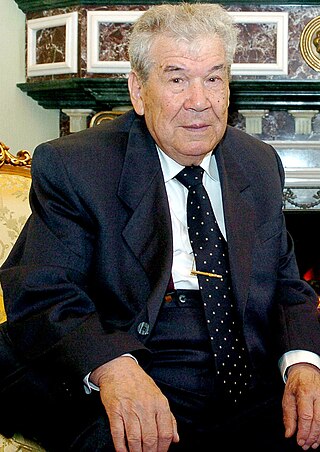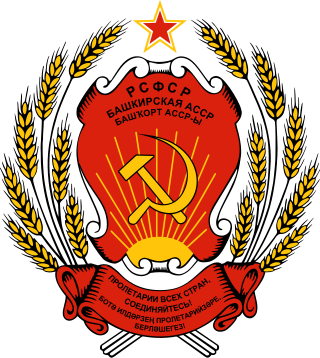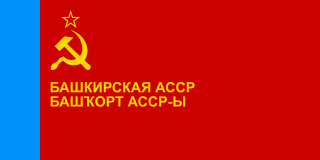
The penultimate USSR-era flag was adopted by the Russian Soviet Federative Socialist Republic (RSFSR) in 1954 and used until 1991. The flag of the Russian SFSR was a defacement of the flag of the USSR. The constitution stipulated:
The state flag of the Russian Soviet Federative Socialist Republic (SFSR) presents itself as a red, rectangular sheet with a light-blue stripe at the pole extending all the width [read height] which constitutes one eighth length of the flag.

Russia Day called Day of adoption of the Declaration of State Sovereignty of RSFSR before 2002, is the national holiday of the Russian Federation. It has been celebrated annually on 12 June since 1992. The day commemorates the adoption of the Declaration of State Sovereignty of the Russian Soviet Federative Socialist Republic (RSFSR) on 12 June 1990. The passage of this Declaration by the First Congress of People's Deputies marked the beginning of constitutional reform in the Russian Soviet state.

The republics are one type of federal subject of the Russian Federation. 21 republics are internationally recognized as part of Russia; another is under its de facto control. The original republics were created as nation states for ethnic minorities. The indigenous ethnicity that gives its name to the republic is called the titular nationality. However, due to centuries of Russian migration, a titular nationality may not be a majority of its republic's population. By 2017, the autonomous status of all republics was formally abolished, making the republics politically equivalent to the other federal subjects of Russia.

Bashkortostan or Bashkiria, officially the Republic of Bashkortostan, is a republic of Russia between the Volga river and the Ural Mountains in Eastern Europe. The republic borders Perm Krai to the north, Sverdlovsk Oblast to the northeast, Chelyabinsk Oblast to the east, Orenburg Oblast to the south, Tatarstan to the west and Udmurtia to the northwest. It covers 143,600 square kilometres and has a population of 4 million. It is the seventh-most populous federal subject in Russia and the most populous republic. Its capital and largest city is Ufa.

When the Soviet Union existed, different governments had ruled the northern Caucasus regions of Chechnya and Ingushetia. Within the Mountain Autonomous Socialist Soviet Republic, later annexed into the Russian Socialist Federative Soviet Republic, they were known as the Chechen Autonomous Oblast and the Ingush Autonomous Oblast, which were unified on January 15, 1934, to form the Checheno-Ingush Autonomous Oblast. It was elevated to an autonomous republic as the Checheno-Ingush Autonomous Soviet Socialist Republic from 1936 to 1944 and again from 1957 to 1993. Its capital was Grozny.

The Congress of People's Deputies of the Russian SFSR and since 1992 Congress of People's Deputies of the Russian Federation was the supreme government institution in the Russian SFSR and in the Russian Federation from 16 May 1990 to 21 September 1993. Elected on 4 March 1990 for a period of five years, it was dissolved by presidential decree during the Russian constitutional crisis of 1993 and ended de facto when the Russian White House was attacked on 4 October 1993. The Congress played an important role in some of the most important events in the history of Russia during this period, such as the declaration of state sovereignty of Russia within the USSR, the rise of Boris Yeltsin, and economic reforms.

The flag of the Republic of Bashkortostan is one of the official state symbols of Bashkortostan, a federal subject of Russia, alongside the coat of arms and anthem. The flag has three horizontal stripes. From top to bottom, the stripes are teal blue, white, and green. The flag has been used officially as the flag of the Republic of Bashkortostan since 25 February 1992. The white stripe of the flag is charged with a kurai flower in the center.

The Declaration of State Sovereignty of the Russian SFSR was a political act of the Russian Soviet Federative Socialist Republic, then part of the Soviet Union, which marked the beginning of constitutional reform in Russia. The Declaration was adopted by the First Congress of People's Deputies of the Russian SFSR on 12 June 1990. It proclaimed the sovereignty of the Russian SFSR and the intention to establish a democratic constitutional state within a liberalized Soviet Union. The declaration also states the following:

The Supreme Soviet of the Russian SFSR, later the Supreme Soviet of the Russian Federation, was the supreme government institution of the Russian SFSR from 1938 to 1990; between 1990 and 1993, it was a permanent legislature (parliament), elected by the Congress of People's Deputies of the Russian Federation.

The Russian Soviet Federative Socialist Republic, previously known as the Russian Soviet Republic and the Russian Socialist Federative Soviet Republic, and unofficially as Soviet Russia, was an independent federal socialist state from 1917 to 1922, and afterwards the largest and most populous constituent republic of the Soviet Union (USSR) from 1922 to 1991, until becoming a sovereign part of the Soviet Union with priority of Russian laws over Union-level legislation in 1990 and 1991, the last two years of the existence of the USSR. The Russian SFSR was composed of sixteen smaller constituent units of autonomous republics, five autonomous oblasts, ten autonomous okrugs, six krais and forty oblasts. Russians formed the largest ethnic group. The capital of the Russian SFSR and the USSR as a whole was Moscow and the other major urban centers included Leningrad, Stalingrad, Novosibirsk, Sverdlovsk, Gorky and Kuybyshev. It was the first socialist state in history.
The history of Bashkortostan or Bashkiria covers the region in and around the Southern Urals, historically inhabited by Bashkirs. The region has been known by several names, including al-Bashgird, Bashgirdia, Bascardia, Fiyafi Bashqurt, Pascatir and similar variants. As with previous names, the modern federal subject of Bashkortostan was named after the native Bashkir people.

Mustai Karim was a Bashkir Soviet poet, writer and playwright. He was named People's Poet of the Bashkir ASSR (1963), Hero of Socialist Labour (1979), and winner of the Lenin Prize (1984) and the USSR State Prize (1972).

The Declaration and Treaty on the Formation of the Union of Soviet Socialist Republics officially created the Union of Soviet Socialist Republics (USSR), commonly known as the Soviet Union. It de jure legalised a political union of several Soviet republics that had existed since 1919 and created a new federal government whose key functions were centralised in Moscow. Its legislative branch consisted of the Congress of Soviets of the Soviet Union and the Central Executive Committee of the Soviet Union (TsIK), while the Council of People's Commissars composed the executive.

The Government of Bashkortostan is a governing body of Bashkortostan in Russia which exercises executive power under the authority of the Republic Head whom appoints cabinet which is composed of the Prime Minister, the deputy prime ministers, and the ministers that are approved by the governing legislature is the State Assembly.

The emblem of the Bashkir Autonomous Soviet Socialist Republic was adopted in 1937 by the government of the Bashkir Autonomous Soviet Socialist Republic. Its design is based on the emblem of the Soviet Union.

The national emblem of the Kalmyk Autonomous Soviet Socialist Republic was adopted in 1937 by the government of the Kalmyk Autonomous Soviet Socialist Republic. The emblem is identical to the emblem of the Russian Soviet Federative Socialist Republic.

The flag of the Bashkir Autonomous Soviet Socialist Republic was adopted in 1954 by the government of the Bashkir Autonomous Soviet Socialist Republic. The flag is identical to the flag of the Russian Soviet Federative Socialist Republic.

The 1927 Constitution of the Azerbaijan Socialist Soviet Republic was adopted by the Central Executive Committee of the Azerbaijan SSR at the 5th All-Azerbaijani Congress of Soviets on March 26, 1927.
Zekeria Sharafutdinovich Aknazarov - Soviet statesman and party leader. Chairman of the Council of Ministers of the Bashkir ASSR (1962–1986).
The Bashkir liberation movement is a series of military clashes and uprisings of the Bashkir people against the Russian Empire that colonized Bashkortostan, as well as protests and rallies against the policies of the Russian Federation.















